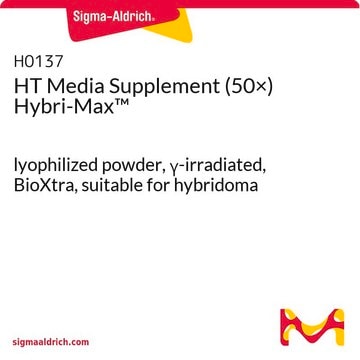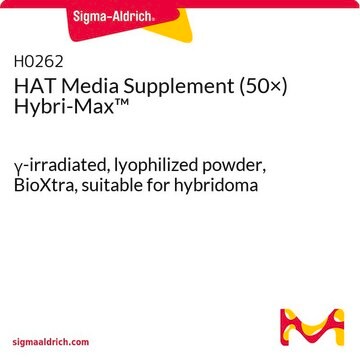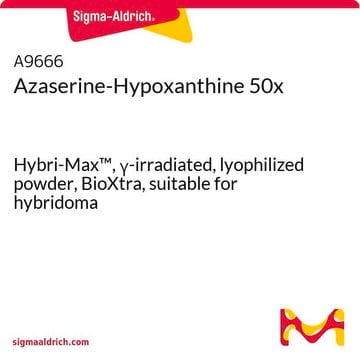O5003
OPI Media Supplement
Hybri-Max™, γ-irradiated, powder, suitable for hybridoma
Synonym(s):
OPI Media for cell culture
Sign Into View Organizational & Contract Pricing
All Photos(1)
About This Item
UNSPSC Code:
12352207
NACRES:
NA.75
Recommended Products
grade
Hybri-Max™
Quality Level
sterility
γ-irradiated
form
powder
concentration
18-40 mg/vial
technique(s)
cell culture | hybridoma: suitable
impurities
endotoxin, tested
storage temp.
−20°C
Related Categories
Application
OPI Media Supplement has been used to grow hybridoma cell lines from XenoMouse strains and BALB/c female mice.
Other Notes
Formulated with: 0.15 g oxaloacetate, 0.05 g pyruvate, and 0.0082 g insulin.
Reconstitution
Reconstitute contents of vial with 10 mL sterile water. Do not use cell culture medium for initial reconstitution. Each vial sufficient to prepare 1 liter of medium. Final working concentration: 1 mM oxaloacetate, 0.45 mM pyruvate, 0.2 U/ml insulin.
Legal Information
Hybri-Max is a trademark of Sigma-Aldrich Co. LLC
Signal Word
Danger
Hazard Statements
Precautionary Statements
Hazard Classifications
Eye Dam. 1 - Skin Corr. 1 - Skin Sens. 1
Storage Class Code
8A - Combustible corrosive hazardous materials
WGK
WGK 1
Flash Point(F)
Not applicable
Flash Point(C)
Not applicable
Certificates of Analysis (COA)
Search for Certificates of Analysis (COA) by entering the products Lot/Batch Number. Lot and Batch Numbers can be found on a product’s label following the words ‘Lot’ or ‘Batch’.
Already Own This Product?
Find documentation for the products that you have recently purchased in the Document Library.
Customers Also Viewed
Andrew W Drake et al.
Analytical biochemistry, 328(1), 35-43 (2004-04-15)
Two biophysical methods, Biacore and KinExA, were used to kinetically and thermodynamically characterize high-affinity antigen/antibody complexes. Three to five independent experiments were performed on each platform with three different antigen/antibody complexes possessing nanomolar to picomolar equilibrium dissociation constants. By monitoring
Jun Yang et al.
Clinical biochemistry, 48(13-14), 843-848 (2015-05-31)
Neurogranin (NRGN) is a small neuronal protein that plays an important role in synaptic signaling by regulating calmodulin (CaM) availability. In this study, we developed an ELISA to measure NRGN quantitatively in serum samples from a cohort of acute traumatic
Gabriela A Canziani et al.
Analytical biochemistry, 325(2), 301-307 (2004-01-31)
Experimental and data analysis protocols were developed to screen antibodies from hybridoma culture supernatants using Biacore surface plasmon resonance biosensor platforms. The screening methods involved capturing antibodies from crude supernatants using Fc-specific antibody surfaces and monitoring antigen binding at a
Andrew W Drake et al.
Analytical biochemistry, 328(1), 35-43 (2004-04-15)
Two biophysical methods, Biacore and KinExA, were used to kinetically and thermodynamically characterize high-affinity antigen/antibody complexes. Three to five independent experiments were performed on each platform with three different antigen/antibody complexes possessing nanomolar to picomolar equilibrium dissociation constants. By monitoring
Tzu-Ling Sung et al.
PLoS pathogens, 5(1), e1000263-e1000263 (2009-01-17)
Cyclin T1 is a regulatory subunit of a general RNA polymerase II elongation factor known as P-TEFb. Cyclin T1 is also required for Tat transactivation of HIV-1 LTR-directed gene expression. Translation of Cyclin T1 mRNA has been shown to be
Our team of scientists has experience in all areas of research including Life Science, Material Science, Chemical Synthesis, Chromatography, Analytical and many others.
Contact Technical Service














